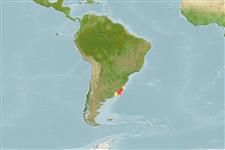Classification / Names
Common names from other countries
Main reference
Size / Weight / Age
Max length : 35.0 cm SL male/unsexed; (Ref. 27363)
Environment
Marine; brackish; pelagic-neritic; depth range 5 - ? m (Ref. 188)
Climate / Range
Subtropical, preferred 16°C (Ref. 107945); 30°S - 40°S, 60°W - 48°W (Ref. 188)
Distribution
Short description
Dorsal
spines
(total): 0;
Dorsal
soft rays
(total): 16;
Anal
spines: 0;
Anal
soft rays: 19. Scutes apparent along belly. Upper jaw with distinct median notch. Pectoral fin tip to pelvic fin base or at most short by the width of 3 scales; pelvic fin with oblique and almost straight hind margin. Pre-dorsal scales modified; scales on back and above base of anal fin not markedly smaller than rest (Ref. 188). Back of body greenish blue, sides and belly silvery, fins golden yellow. Large dark spot behind gill cover (Ref. 27363).
IUCN Red List Status (Ref. 115185)
Threat to humans
Harmless
Human uses
Fisheries: minor commercial
More information
ReferencesAquacultureAquaculture profileStrainsGeneticsAllele frequenciesHeritabilityDiseasesProcessingMass conversion
Tools
Special reports
Download XML
Internet sources
Estimates of some properties based on models
Phylogenetic diversity index
PD50 = 0.5156 many relatives (e.g. carps) 0.5 - 2.0 few relatives (e.g. lungfishes)
Trophic Level
3.4 ±0.45 se; Based on food items.
Resilience
High, minimum population doubling time less than 15 months (Assuming tm=1)
Vulnerability
Moderate vulnerability (37 of 100)
Price category
